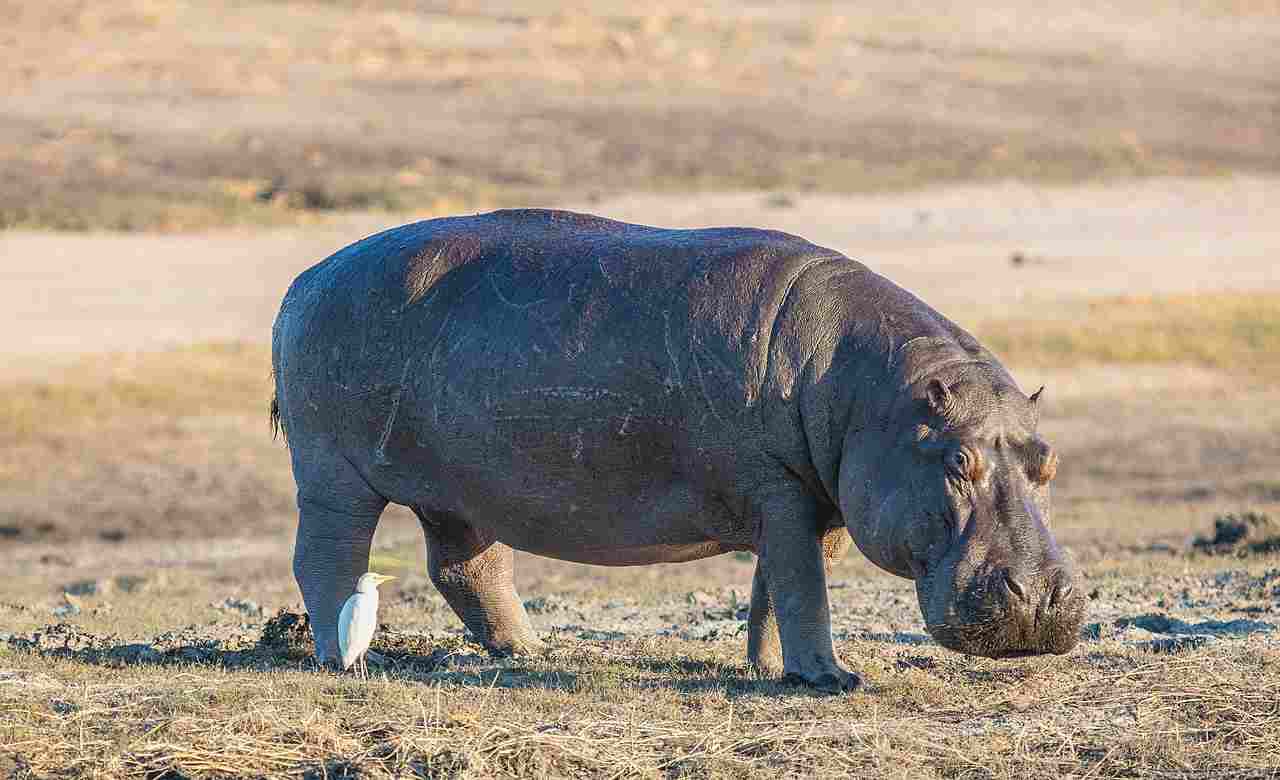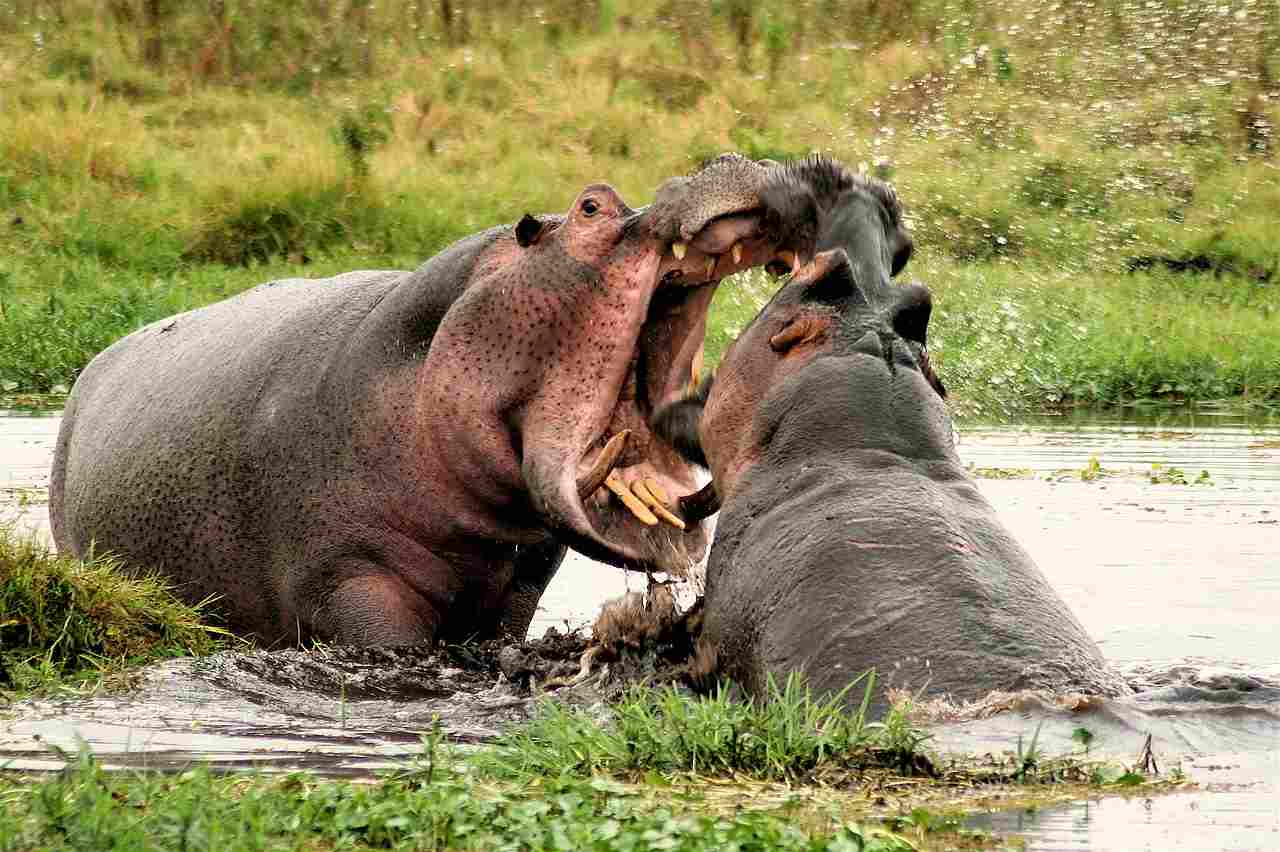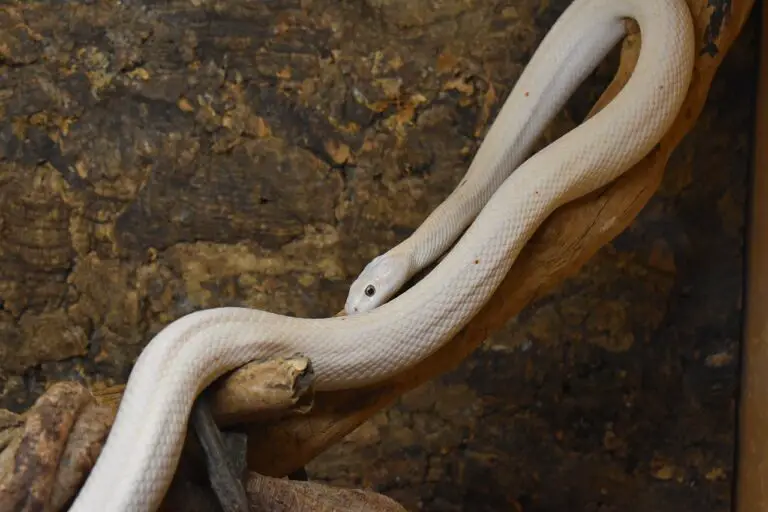Hippo Vs Tiger Size, Weight, Ecological Comparison
The size and weight of a hippo give it a clear advantage over a tiger in a hypothetical battle. Hippos are massive creatures, weighing up to 4,000 kilograms, while tigers typically weigh around 300 kilograms. This significant difference in size and weight gives hippos greater strength and power. Additionally, hippos have incredibly strong jaws and thick skin, making them formidable opponents. When comparing these animals, it is evident that the hippo’s physical attributes make it the stronger contender.
Key Outcomes
*Biological Comparison
Hippopotamuses and tigers may seem like completely different animals, but they do share some biological similarities. Despite their differences in appearance and habitat, both species belong to the animal kingdom and are classified as mammals. However, they are not biologically related and belong to different genus and species.
Hippos belong to the genus Hippopotamus, with the common hippopotamus being classified as Hippopotamus amphibius. Tigers, on the other hand, belong to the genus Panthera, with the Bengal tiger being classified as Panthera tigris.
*Size and Weight Comparison
The size and weight comparison between hippos and tigers is an interesting aspect to explore. When it comes to size, hippos are larger than tigers. Adult male hippos can reach lengths of up to 15 feet and stand around 5 feet tall at the shoulder. In comparison, tigers can grow up to 11 feet in length and stand around 3 feet tall at the shoulder.
In terms of weight, hippos are also heavier than tigers. Adult male hippos can weigh between 3,500 to 9,900 pounds, while tigers typically weigh between 200 to 670 pounds.
*Physical Capability Comparison
Hippos are far stronger than tigers due to their larger size and greater weight. This physical advantage gives hippos the ability to overpower and potentially cause the death of a tiger in a confrontation. When comparing the physical capabilities of these animals, it is clear that the sheer size and strength of hippos give them a significant advantage in terms of power and force.
1). Taxonomy
The taxonomy of hippos and tigers reveals interesting insights into their evolutionary history and biological classification. Hippos belong to the genus Hippopotamus, with two extant species: the common hippopotamus (Hippopotamus amphibius) and the pygmy hippopotamus (Choeropsis liberiensis). On the other hand, tigers are classified under the genus Panthera, specifically Panthera tigris, with several subspecies such as the Bengal tiger and the Siberian tiger.
When comparing the taxonomy of these animals, it is evident that they belong to different genera and species, highlighting their distinct evolutionary paths. While hippos are more closely related to whales and dolphins, tigers share a common ancestry with other big cats like lions, leopards, and jaguars.
Understanding the taxonomy of hippos and tigers provides a foundation for further exploration into their unique characteristics and behaviors. By examining their genetic relationships, scientists can gain insights into their shared traits and adaptations to their respective environments.
2). Appearance
The appearance of hippos and tigers is distinct and adapted to their respective environments. Starting with their coats, hippos have thick, hairless skin that is grayish-brown in color. This unique skin adaptation helps them stay cool in the hot African sun and protects them from sunburn. Tigers, on the other hand, have a beautiful coat of fur with distinctive patterns of stripes that provide excellent camouflage in their forest and grassland habitats.
In terms of stature and build, hippos are known for their large, barrel-shaped bodies and short legs. They have a massive head with a wide mouth and large teeth. Tigers, on the contrary, have a more agile and muscular build. They are sleek and have a long body, powerful legs, and a strong jaw equipped with sharp teeth.
When comparing the appearance of these animals, it is clear that they have evolved different physical characteristics to suit their lifestyles. Hippos’ hairless skin and robust bodies are adapted for a semi-aquatic life, while tigers’ striped fur and agile build enable them to hunt and move stealthily in their habitats.
3). Size
When comparing the size of hippos and tigers, it is important to consider their total body length and height at the shoulders. Hippos are known for their massive size, with adult males reaching lengths of up to 5 meters (16 feet) and standing at a height of around 1.5 meters (5 feet) at the shoulders. Tigers, on the other hand, are slightly smaller in size. Adult male tigers typically measure around 2.5 to 3 meters (8 to 10 feet) in length and stand at a height of approximately 1 meter (3 feet) at the shoulders.
The size difference between these two animals is quite significant. Hippos are much larger and bulkier compared to tigers. This is mainly due to their semi-aquatic lifestyle, which requires them to have a large body to navigate through water and defend their territories. Tigers, on the contrary, have a more streamlined and agile build, allowing them to move swiftly and silently in their habitats.
In terms of size, hippos clearly outweigh tigers. Their massive bodies and impressive stature make them one of the largest land mammals, while tigers, although smaller in comparison, are still formidable predators in their own right.

4). Weight
When comparing the weight of hippos and tigers, it is evident that hippos are significantly heavier than tigers. Adult male hippos can weigh anywhere between 1,500 to 3,200 kilograms (3,300 to 7,000 pounds), making them one of the heaviest land mammals. In contrast, adult male tigers typically weigh around 180 to 300 kilograms (400 to 660 pounds).
The weight difference between these two animals is substantial. Hippos have a dense and muscular body structure, which allows them to thrive in water and navigate through their aquatic habitats. Their weight is essential for maintaining buoyancy and stability in the water. Tigers, on the other hand, have a more slender and agile build, which is better suited for their hunting and climbing abilities.
The weight of hippos gives them a significant advantage when it comes to territorial disputes and defense against predators. Their sheer mass and strength make them formidable opponents. Tigers, although lighter in comparison, compensate for their weight with their agility, speed, and powerful hunting techniques.
5). Bite Force
Hippos have an incredibly powerful bite force, with estimates ranging from 1,800 to 2,000 psi. This immense strength allows them to crush through tough vegetation, as well as defend themselves against potential threats. In contrast, tigers have a bite force of around 1,050 psi, which is still formidable but not as strong as that of a hippo.
The difference in bite force between these two animals can be attributed to their respective diets and feeding habits. Hippos primarily feed on vegetation, requiring a strong bite to break down tough plant material. Tigers, on the other hand, are carnivores and rely on their bite force to subdue and kill their prey.
While both hippos and tigers possess impressive bite forces, hippos have a stronger bite due to their specialized diet and the need to process tough vegetation. This adaptation allows them to thrive in their habitats and fulfill their ecological roles as herbivores.
6). Overall Physical Capacity (Which is Stronger?)
When comparing the overall physical capacity of hippos and tigers, several factors need to be considered. Both animals possess unique strengths and adaptations that contribute to their survival in their respective habitats.
In terms of sheer size and weight, hippos are undoubtedly stronger. With an average weight of 3,000 to 4,000 pounds, they are one of the largest land mammals. Tigers, on the other hand, weigh around 400 to 600 pounds, making them significantly smaller in comparison. This size advantage gives hippos a greater advantage in terms of physical strength and dominance.
However, when it comes to agility and speed, tigers have the upper hand. Tigers are known for their incredible speed and agility, capable of reaching speeds of up to 40 to 50 miles per hour. This agility allows them to swiftly maneuver and outmaneuver their prey, making them formidable hunters.
In a violent confrontation between a hippo and a tiger, it is difficult to determine which animal would come out as the victor. Both possess unique strengths that could potentially cause the death of the other. The massive size and strength of a hippo could overpower a tiger, while the agility and predatory skills of a tiger could prove fatal for a hippo.
7). Habitat
The habitat of hippos and tigers plays a crucial role in shaping their behavior and survival strategies. Hippos are primarily found in sub-Saharan Africa, where they inhabit rivers, lakes, and swamps. They are well-adapted to aquatic environments, with their barrel-shaped bodies, webbed feet, and eyes, ears, and nostrils positioned on the top of their heads. This allows them to stay submerged in water for long periods and emerge only to graze on land during the night. Hippos are highly territorial and mark their territories by defecating and urinating along the banks of their habitats.
Tigers, on the other hand, have a much wider geographic range. They are found in various habitats across Asia, including forests, grasslands, and mangrove swamps. Tigers are solitary animals and require large territories to roam and hunt. They are excellent swimmers and are known to cross rivers and lakes in search of prey. Tigers are highly adaptable and can thrive in diverse ecosystems, from the snowy mountains of Siberia to the dense jungles of India.
While both hippos and tigers have specific habitat requirements, their habitats differ significantly in terms of geographic range and ecosystems. Hippos are restricted to specific regions in Africa, while tigers have a much broader distribution across Asia.
8). Lifespan
When comparing the lifespan of hippos and tigers, it is evident that there is a significant difference between the two animals. Hippos have an average lifespan of around 40 to 50 years in the wild, although some individuals have been known to live up to 60 years. On the other hand, tigers have a shorter lifespan, with an average of 10 to 15 years in the wild.
The longevity of hippos can be attributed to their herbivorous diet and relatively low predation risk. They have a slow metabolic rate and spend a significant amount of time in water, which helps protect them from predators. Additionally, hippos have thick skin that provides protection against the sun and potential injuries.
In contrast, tigers face numerous threats that contribute to their shorter lifespan. Habitat loss, poaching, and conflicts with humans are major factors that impact tiger populations. Tigers also have a higher metabolic rate due to their carnivorous diet, which requires more energy and puts additional stress on their bodies.
Overall, the lifespan of hippos is considerably longer than that of tigers. This difference can be attributed to various factors, including diet, habitat, and predation pressure.
9). Behavior
When comparing the behavior of hippos and tigers, several key differences emerge. Firstly, in terms of feeding, hippos are herbivores, primarily grazing on grasses and aquatic plants. They spend a significant amount of time in water, using their powerful jaws and sharp incisors to tear and chew vegetation. On the other hand, tigers are carnivores, relying on hunting and consuming meat for sustenance. They are skilled predators, using their agility, strength, and sharp teeth to capture and kill their prey.
In terms of aggression, both hippos and tigers can display aggressive behavior, but their motivations and methods differ. Hippos are known for their territorial nature and can become extremely aggressive, especially when they feel threatened or when protecting their young. They are responsible for more human deaths in Africa than any other large animal. Tigers, on the other hand, are solitary animals and are generally less aggressive towards humans unless provoked or cornered.
Vocalization is another aspect of behavior where hippos and tigers differ. Hippos are known for their distinctive vocalizations, which include grunts, roars, and snorts. These vocalizations serve as a means of communication between individuals and can also be used to establish dominance or defend territory. Tigers, on the other hand, are more stealthy and rely on silent stalking techniques when hunting. They communicate through various vocalizations, including growls, hisses, and chuffing sounds.
In terms of social behavior, hippos are semi-social animals, often forming small groups called pods. These pods consist of a dominant male, several females, and their offspring. Tigers, on the other hand, are solitary animals, with males and females coming together only for mating purposes.
When it comes to parenting, hippos and tigers also differ. Female hippos are responsible for raising their young, while male tigers do not participate in parenting. Female hippos are highly protective of their calves and will fiercely defend them against any potential threats.

10). Reproduction
When comparing the reproduction of hippos and tigers, several key differences emerge. Firstly, hippos are viviparous, meaning they give birth to live young. Female hippos have a gestation period of around 8 months before giving birth to a single calf. Tigers, on the other hand, are also viviparous and give birth to live cubs after a gestation period of approximately 3 to 4 months.
In terms of the number of offspring produced, hippos typically have one calf at a time, while tigers can have a litter of 2 to 4 cubs. This difference in litter size is due to the different reproductive strategies of the two species.
Another aspect to consider is the level of parental care provided by each species. Female hippos are highly protective of their calves and will nurse and care for them for several months. Male tigers, on the other hand, do not participate in parenting and the female is solely responsible for raising the cubs.
When it comes to the survival of the offspring, both hippos and tigers face challenges. Hippos face predation from crocodiles and lions, while tiger cubs are vulnerable to predation by other predators and may also face competition for resources within their habitat.
11). Danger Posed to Humans
When considering the danger posed to humans by hippos and tigers, there are several factors to take into account. Firstly, hippos are known to come close to human settlements, particularly in areas where their natural habitat has been encroached upon. While they may appear docile, hippos can be extremely aggressive and territorial, especially when they feel threatened or when protecting their young. This aggression has led to numerous human deaths, particularly in Africa where interactions between humans and hippos are more common.
On the other hand, tigers generally avoid human settlements and prefer to stay within their own territories. However, there have been instances where tigers have attacked humans, especially when they feel cornered or when their natural prey is scarce. These attacks are relatively rare, but they can be fatal.
If you encounter a hippo or a tiger in the wild, it is important to exercise caution and take appropriate precautions. For hippos, it is best to keep a safe distance and avoid any sudden movements that may provoke them. In the case of tigers, it is important to make yourself appear larger and back away slowly without turning your back on the animal.
In terms of the rate of human deaths caused by these animals, hippos are responsible for more fatalities compared to tigers. This is mainly due to the fact that hippos have more frequent interactions with humans in certain regions.

12). Conservation Status
When it comes to the conservation status of hippos and tigers, both species face significant challenges. Hippos are currently classified as “vulnerable” by the International Union for Conservation of Nature (IUCN). This means that they are at a high risk of extinction in the wild if conservation efforts are not implemented. The main threats to the survival of wild hippo populations include habitat loss, poaching for their ivory-like teeth, and conflicts with humans due to encroachment on their natural habitat.
On the other hand, tigers are classified as “endangered” by the IUCN, which means they are at a very high risk of extinction in the wild. The main threats to wild tiger populations include habitat loss, poaching for their skin and body parts, and conflicts with humans due to illegal hunting and habitat destruction.
In terms of comparison, both hippos and tigers face similar threats to their survival, such as habitat loss and poaching. However, tigers are generally considered to be in a more critical situation due to their smaller population size and more fragmented habitats.
Conservation efforts for both species are crucial to ensure their long-term survival. These efforts include the establishment of protected areas, anti-poaching measures, habitat restoration, and community engagement.

Conclusion
I). SIMILARITIES
In conclusion, when comparing hippos and tigers, there are several similarities between these two magnificent animals. Both hippos and tigers face significant threats to their survival, including habitat loss and poaching. Conservation efforts are crucial for the long-term survival of both species. The establishment of protected areas, anti-poaching measures, habitat restoration, and community engagement are essential for their conservation.
II). DIFFERENCES
Despite their similarities, there are also notable differences between hippos and tigers. Hippos are classified as “vulnerable” by the IUCN, while tigers are classified as “endangered.” Tigers are generally considered to be in a more critical situation due to their smaller population size and more fragmented habitats. Additionally, tigers face the additional threat of illegal hunting for their skin and body parts.
In terms of size and weight, hippos are larger and heavier than tigers. Hippos have a robust build and can weigh up to 3,000 kilograms, while tigers are more agile and weigh around 200 to 300 kilograms. Furthermore, hippos have a powerful bite force, while tigers rely on their speed and agility for hunting.




